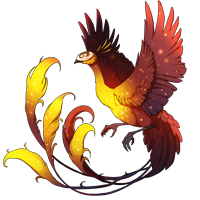

Ishu
(#53922650)
Level 1 Skydancer
Click or tap to view this dragon in Predict Morphology.
Energy: 50/50

Expand the dragon details section.
Collapse the dragon details section.
Personal Style
Apparel















Skin

Scene

Measurements
Length
5.6 m
Wingspan
4.96 m
Weight
754.62 kg
Genetics
Obsidian
Giraffe
Giraffe
Black
Hex
Hex
Blood
Okapi
Okapi
Hatchday
Breed
Eye Type
Level 1 Skydancer
EXP: 0 / 245


STR
4
AGI
5
DEF
4
QCK
9
INT
9
VIT
4
MND
9
Biography
| xxxxxxxxxxxxxx |
Dark flow from the oldest shrines,
Blight and blood under the wealth and wine ▀ now In present times, the legend of Ishu, the Six-Winged Dragon, continues to captivate the imaginations of those who delve into Slavic mythology and folklore. Although the direct worship and rituals associated with Ishu have diminished over the centuries, its influence and symbolism endure. Ishu has become a cherished figure in modern Slavic culture, representing the deep connection between the Slavic people and their natural surroundings. Many view Ishu as a guardian spirit, an embodiment of the untamed wilderness and the primal forces that shape the world. Its image often adorns artwork, tapestries, and jewelry, serving as a reminder of the ancient bonds between humanity and nature. In certain regions, particularly where Slavic traditions have been preserved, festivals and events celebrating Ishu are held, allowing people to reconnect with their ancestral heritage. These festivities feature vibrant displays of traditional dances, music, and storytelling, where tales of Ishu's heroic deeds and wisdom are shared with new generations. Furthermore, Ishu's symbolism continues to inspire those who strive for environmental conservation and the preservation of natural habitats. Many conservation organizations, inspired by the dragon's mythical status as a protector of nature, adopt Ishu as their emblem, emphasizing the need to honor and respect the earth's resources. In popular culture, Ishu has made appearances in various forms of media, including literature, art, and video games. Authors and artists often incorporate Ishu as a majestic and formidable creature, weaving its mythical presence into fantastical narratives that enchant readers and viewers. It is important to note that interpretations of Ishu may vary across different regions and communities. Some may perceive it as a literal dragon-like being, while others may view it as a metaphorical representation of the elemental forces of nature. Regardless of the interpretation, Ishu's legacy endures as a symbol of Slavic identity, strength, and the profound connection between humanity and the natural world.▄ xx
Nie rzucim ziemi, skąd nasz ród.
Nie damy pogrześć mowy. Polsk¡ my naród, polsk¡ lud, Królewski szczep piastowy. Nie damy, by nas gnębił wróg. ▀ then In the ancient lands of Slavic mythology, there existed a legendary creature known as Ishu, the Six-Winged Dragon. Ishu was an awe-inspiring being, revered by the Slavic people as a symbol of power, wisdom, and protection. Its name, derived from the Old Slavic word for "fire," embodied its fiery essence and its connection to the natural world. According to the ancient tales, Ishu was born in the heart of the sacred Slavic forests, emerging from the union of the celestial forces and the primal energy of the earth. Its six mighty wings, adorned with vibrant feathers in shades of gold, crimson, and emerald, were said to shimmer like flames as it soared through the heavens. Each wing represented an element—fire, water, earth, air, spirit, and shadow—symbolizing Ishu's dominion over the forces of nature. Ishu possessed the ability to manipulate these elemental energies, shaping them to its will. It could conjure raging infernos, summon torrential storms, reshape mountains, and command the very essence of life. Its mastery over shadow allowed it to blend seamlessly with the darkness, rendering it invisible to the eyes of mortal beings when it wished to remain unseen. Although fierce and mighty, Ishu was not a malevolent creature. It possessed a deep sense of guardianship towards the Slavic lands and its people, acting as a protector against threats that endangered the balance of nature. Legends spoke of Ishu appearing in times of great need, its majestic presence inspiring courage and hope among those who beheld it. Its voice, a harmonious blend of thunder and whispers, carried ancient wisdom and echoed through the forests, guiding lost souls and weary travelers to safety. The Slavic people held Ishu in high esteem, offering it reverence and veneration in rituals and celebrations. Temples dedicated to Ishu stood tall in sacred groves, where priests and priestesses sought its wisdom and performed rituals to ensure the prosperity and harmony of their communities. It was believed that those who upheld the values of respect for nature, wisdom, and balance would receive Ishu's blessings and protection. However, Ishu's existence was not without challenges. Dark forces and malevolent entities sought to exploit its powers for their own gain, attempting to subdue or control the mighty dragon. Yet Ishu's innate wisdom and unyielding spirit protected it from such threats, ensuring that its fiery essence remained untamed and free. As time passed and the world changed, the worship of Ishu waned, fading into the realm of myth and legend. Yet, its legacy endured, leaving an indelible mark on Slavic folklore and inspiring generations with its majestic presence and the ideals it represented. Ishu, the Six-Winged Dragon, became a symbol of the interconnectedness of nature, the power of the elements, and the harmony between humans and the world around them.▄ xx
Nie damy miana Polsk¡ zgnieść
Nie pójdziem żywo w trumnę. Na Polsk¡ imię, na jej cześć Podnosim czoła dumne, Odzyska ziemię dziadów wnuk. ▀ around Some fun facts about Ishu, the Six-Winged Dragon: 1. Shape-Shifting Guardian: Ishu possessed the ability to shape-shift, allowing it to assume various forms, not just that of a dragon. It could transform into other animals or even take on a human-like appearance, blending seamlessly into its surroundings. 2. Elemental Mastery: Each of Ishu's six wings represented a different element—fire, water, earth, air, spirit, and shadow. This remarkable attribute granted Ishu unparalleled control over the forces of nature, making it a truly awe-inspiring and formidable creature. 3. Invisible in the Shadows: Thanks to its mastery over shadow, Ishu had the ability to become invisible when it desired. It could effortlessly merge with darkness, moving undetected through the night and surprising those who dared to challenge it. 4. Voice of Thunder and Whispers: Ishu's voice was a blend of thunderous roars and gentle whispers. When it spoke, the earth trembled, and its words resonated with ancient wisdom, instilling a sense of awe and reverence in those fortunate enough to hear them. 5. Protector of Lost Souls: Ishu was not only a guardian of the physical world but also a guide for lost souls. It possessed an innate sense of direction and would often appear to travelers who had strayed from their path, leading them back to safety with its majestic presence. 6. Respected Symbol of Slavic Identity: Ishu has become an iconic symbol of Slavic identity, revered for its connection to nature, wisdom, and strength. Its image is often used in modern Slavic art, literature, and cultural events, reminding people of their rich heritage and the importance of preserving the natural world. 7. Inspiring Legends and Folklore: Ishu's tales and adventures have captivated generations of storytellers. Its mythology continues to inspire countless stories, poems, and songs, allowing the spirit of Ishu to live on in the imaginations of people around the world. 8. Icon of Environmental Conservation: Ishu's symbolism as a guardian of nature has transcended ancient mythology. In modern times, it serves as a reminder of the importance of environmental conservation, inspiring individuals and organizations to protect and preserve the natural world. Ishu is an awe-inspiring creature that commands attention and captures the imagination with its majestic presence. Standing tall, Ishu embodies both grace and power in its physical form. Ishu's body is massive, reflecting its immense strength and mythical status. It possesses a sleek, serpentine form, adorned with iridescent scales that shimmer in hues reminiscent of fire. The scales themselves are a tapestry of colors, ranging from deep crimson to vibrant gold, reflecting the fiery essence that courses through its being. These radiant scales glisten and sparkle as if touched by eternal flames, giving Ishu an ethereal and otherworldly appearance. Its head is regal and noble, adorned with elegant, curved horns that arc backward. These horns possess a pearlescent sheen, further accentuating Ishu's celestial nature. Its eyes, mesmerizing and piercing, glow with an inner light, reflecting the wisdom and ancient knowledge that reside within. They are often described as orbs of molten gold, filled with a tranquil and profound understanding. Ishu's most distinctive feature is its six wings, extending majestically from its broad back. Each wing represents an element and is a testament to Ishu's dominion over the forces of nature. The wings are resplendent with feathers, which mirror the hues of the scales, exhibiting a mesmerizing blend of gold, crimson, and emerald. These feathers catch the light as Ishu moves, creating an ethereal display of colors that seems to dance in harmony with the wind. When in flight, Ishu's wings carry it with effortless grace, propelling it through the heavens. The beating of its wings produces a gentle rush of air, a soothing melody that whispers secrets of the natural world and the mysteries of the cosmos. Ishu's limbs are strong and muscular, capable of both agility and power. Its talons, sharp and formidable, serve as a reminder of its ability to defend itself and those under its protection. Its long, sinuous tail trails behind, swaying with a sense of balance and poise, as if attuned to the rhythmic pulse of the earth itself. Overall, Ishu presents a captivating image—an embodiment of raw elemental energy and divine grace. Its radiant presence, resplendent scales, and majestic wings make it an unforgettable sight, symbolizing the profound connection between humanity, nature, and the spiritual realm.▄ | xxxxxxxxxxXxxx |
leaflet | credits

Ishu
Meaning: A Ray of Light; Angel Sweet Lovely Beautiful; King; .
Notes:
Meaning: A Ray of Light; Angel Sweet Lovely Beautiful; King; .
- Mixture of Dandere and Kuudere; albeit very calm, he seems to be outwardly cold, as if harboring some deep secret that makes him bitter towards life. That is not the case of course, but he still comes off as cynical or indifferent.
- Rumors have sprouted, stating that he may very well be the son of Swaróg, the Slavic God of Fire, the Sun, Sky and Blasksmithing
- Wings are natural, made of fire and feather, similar to a phoenix. He can set them ablaze at will and it will not hurt him, only those he wishes the flames to affect
- An expert blacksmith and excellent at flame magic, Ishu is outwardly indifferent to his gifts, while internally being very nurturing of them and wanting to better himself each day
- Many speculate that the deep red markings on his tail, limbs, neck and horns are burns from some terrible terrible accident. This may never be verified
- Ishu has a pair of 6 wings total
- Ishu is associated with many creatures, however, his signature animals are Simurgl, the slavic fiery god-wolf, and Raróg, the dragon-egg-born firebird of Slavic myths.
- The flames that he is able to conjure up, the will-o-embers, each hold a different Slavic rune in their center that glows with a slightly palet shade than the fire that surrounds it. These runes have been noted to change often, from single letters to symbols and sometimes even the Gods' runes/sigils themselves.
The scars that adorn Ishu's body tell tales of battles fought, trials endured, and challenges overcome. Each mark represents a moment of struggle and triumph, showcasing Ishu's indomitable spirit and unwavering determination.
The origins of Ishu's scars are intertwined with the ancient legends and myths of Slavic folklore. They are a testament to the adversaries and threats Ishu faced in its role as a guardian of the natural world.
Some scars were inflicted by fierce battles with dark forces and malevolent entities that sought to exploit Ishu's powers or disrupt the balance of nature. These conflicts may have included confrontations with powerful sorcerers, wicked spirits, or even other legendary creatures of chaos. The scars on Ishu's body bear witness to these epic struggles, marking the places where Ishu stood firm, defending the harmony of the world against overwhelming odds.
Other scars may have been acquired during Ishu's interactions with the forces of nature itself. The volatile power of the elements, which Ishu commands, can be both destructive and unpredictable. As Ishu sought to maintain equilibrium, harnessing and redirecting elemental forces, it may have been occasionally caught in the crossfire, resulting in scars that serve as reminders of the immense energies it wields.
It is also believed that some scars were self-inflicted, the result of Ishu's relentless quest for knowledge and wisdom. In its pursuit of understanding the intricate tapestry of existence, Ishu may have ventured into treacherous realms, delving deep into the mysteries of the universe. These self-imposed challenges and quests for enlightenment may have left their mark on Ishu's body, representing the price paid in the pursuit of profound truths.
Despite the scars that mar its body, Ishu remains an embodiment of resilience and strength. Each mark is a testament to its enduring spirit and the victories it has achieved. These scars become a source of pride, displaying the trials faced and overcome, and serving as a reminder of Ishu's unwavering dedication to protecting the natural world and maintaining harmony within it.
Saraceaser wrote on 2019-09-13 08:21:31:
(Your Dragons are as gorgeous as always! <3 I wanted to do a Dragon that didn't have that many Headcanons and such as is, and I saw this child with that skincent~ Went with neutral pronouns (- changed to He/Him!) feel free to change it if you want to use this or whatever. :3)
Ishu wrote:
Ishu is wingless. He's long since accepted it for the way it is. He don't like talking about it, because he wasn't always wingless; even so, most others, especially those in the Clan, are polite enough to not stare too long or mention it unless it's brought up first. Even so, Ishu avoids sleep as much as possible; nightmares don't plague him as much as dreams of days of flying through the air do, and those hurt the most.
Ishu x2 wrote:
Ishu doesn't have normal wings, like other Skydancers; his are made of fire. Though he honestly can't remember when they became like that, one day they just were. Even so, he remembers a time before when he did have normal wings, when he didn't have to worry about every low-ceiling room he walks into catching on fire by accident. Still, the heat has its advantages, such as abating the icy temperatures of winter.
Bloopp wrote on 2020-09-11 08:23:28:
"Get out of here before I set you on fire-"
airemarshal wrote on 2020-09-11 17:34:55:
"one more word and i will set you on fire"
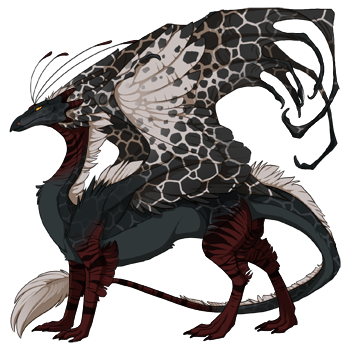
Previously this skin:
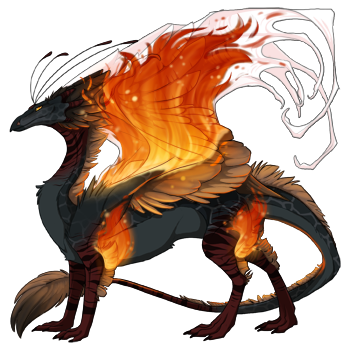
Currently:

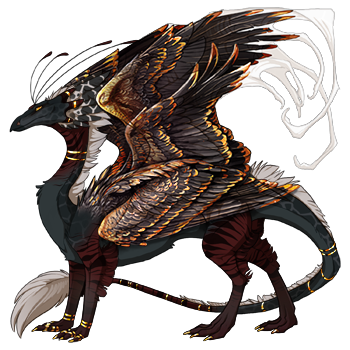
GOALS ACHIEVED!!
Next up:
Glowing | Dark Sclera | Innocent ?
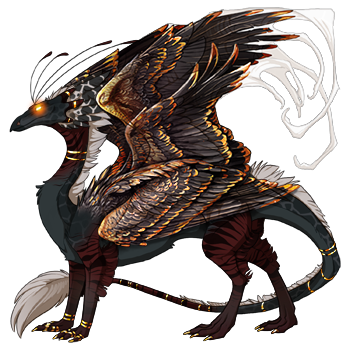


His companion, Simargl (wolf god) and Raróg (slavic dragon-phoenix)








Click or tap a food type to individually feed this dragon only. The other dragons in your lair will not have their energy replenished.
Feed this dragon Insects.
This dragon doesn't eat Meat.
This dragon doesn't eat Seafood.
Feed this dragon Plants.
Exalting Ishu to the service of the Icewarden will remove them from your lair forever. They will leave behind a small sum of riches that they have accumulated. This action is irreversible.
Do you wish to continue?
- Names must be longer than 2 characters.
- Names must be no longer than 16 characters.
- Names can only contain letters.
- Names must be no longer than 16 characters.
- Names can only contain letters.





